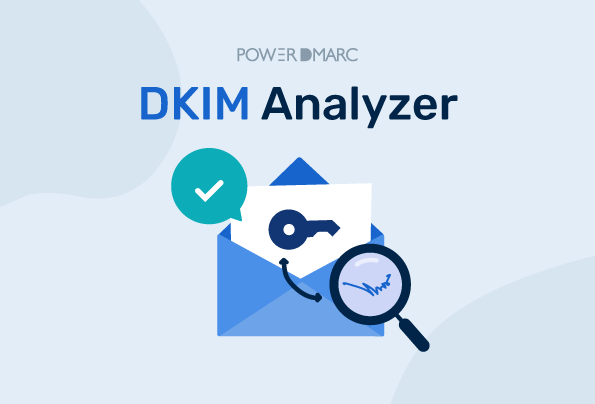Have you ever wondered what a DKIM analyzer is? DKIM stands for DomainKeys Identified Mail, and it’s a method of sending emails that verify the source of an email. It’s commonly used by companies to protect their brands from being spoofed by spammers who want to send out fake emails with the company’s name on them.
What is DKIM Analyzer?
DKIM analyzer is a tool that analyzes and monitors the DKIM signature of your organizational domain aligned or unaligned. Doing so, helps you decipher whether your emails are passing DKIM or failing it. This is an important step to understand whether your emails are being tampered with in transit, or failing delivery unnecessarily due to syntax errors.
When you sign up for DKIM, your domain will have a public key and a private key. The sending email server adds a signature to the message header called “private key” which is encrypted and the email receiver makes a DNS query to fetch the “public key,” to decode the private key and verify the integrity of a message and the singing authority.
When someone receives an email from you using DKIM, they can check whether or not it was signed using your private key; if so, then they know that the message came from an official source. Otherwise, they’ll be able to see that the message wasn’t signed and therefore could be considered spam or phishing attempts trying to steal personal information like passwords or credit card numbers.
How to analyze DKIM results?
You may analyze DKIM manually, or automatically. Let’s explore both below:
Manual DKIM analyzation
To analyze DKIM results manually
1. Open the message (the DKIM results for which you want to analyze) in your mailbox. Here we are taking the example of a Gmail inbox. Click on “More” > “Show Original”
2. Under Original Message, you can inspect your DKIM header results
Here the message passed DKIM. In case it failed, the status will mention “FAIL” for the given domain name.
3. You can further investigate your message headers by scrolling down to view the raw file. Search for “Authentication-Results:”
Drawbacks of the Manual Method
- Lack of complete visibility and transparency
- The reason for DKIM fail not specified
- Difficulty in navigating and troubleshooting issues
- Authentication headers have to be analyzed one email at a time
- Raw files are difficult to read and understand
Automated DKIM Analyzation
To analyze DKIM authentication results automatically:
Method 1
1. Create a free account on PowerDMARC
2. Register your domains
3. Start receiving your DMARC aggregate data with parsed and human-readable SPF and DKIM authentication results for all your sending sources within 24 hours!
4. Import PDF files to share internally, take action against impersonation attempts, get customized email alerts on deliverability and authentication failures, and much more!
Method 2
1. Create a free account on PowerDMARC
2. Navigate to the MailAuth Analyzer tool
3. Copy the auto-generated email address and send a test mail to that address from your mailbox
4. Refresh the MailAuth page on the dashboard and click on the view button on the action panel to start a quick DKIM analysis.
Note: The second method is suitable for instant testing and monitoring, while the first method serves a long-term purpose.
Start Analyzing DKIM Today!
Analyzing DKIM with a DKIM analyzer can help you stay on top of fraudsters and domain impersonators. You can use it with any mail server, it increases the chances of getting through spam filters and junk folders, and helps preserve your brand reputation.
Misleading messages can lead to all sorts of problems: users may click on links or open attachments in these emails and expose themselves to malware. They can also be used to steal credentials for banking and other accounts or spread false information through social media. Configure a DKIM analyzer to ensure your emails are authenticated and protected against external threats!
- SMTP Yahoo Error Codes Explained - May 1, 2024
- SPF Softfail Vs Hardfail: What’s the Difference? - April 26, 2024
- FTC Reports Email is a Popular Medium for Impersonation Scams - April 16, 2024
